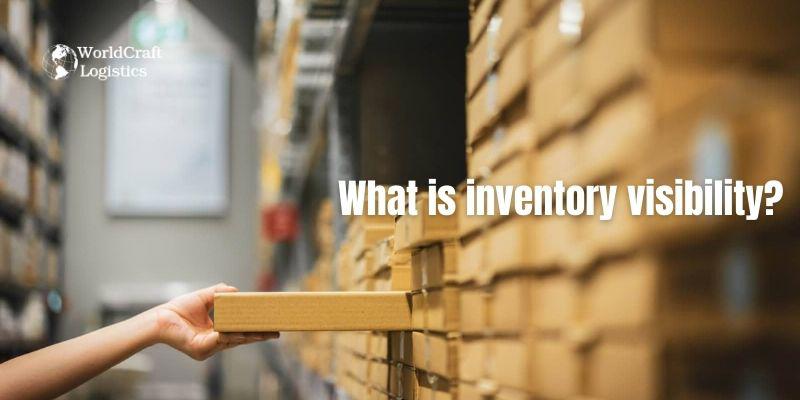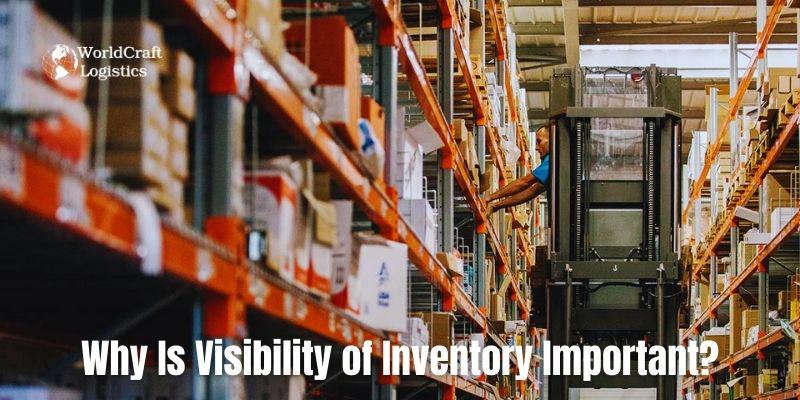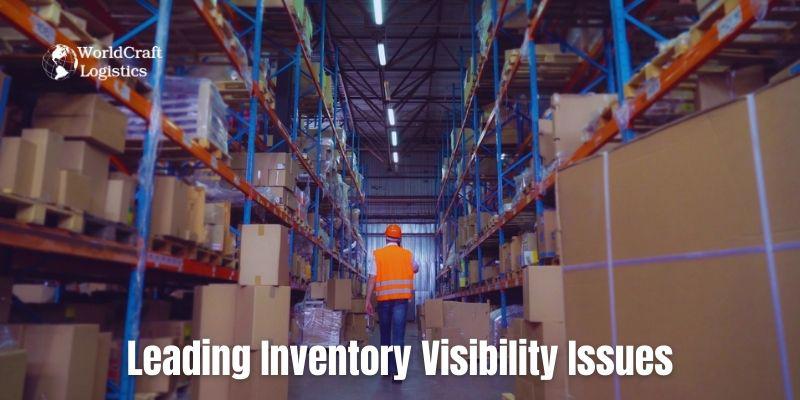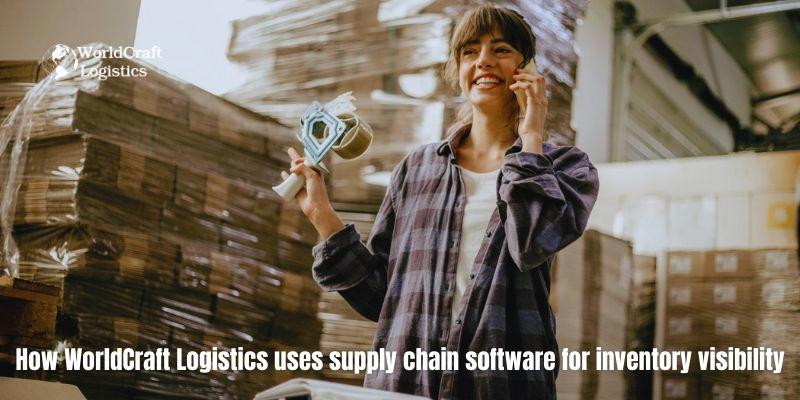
Starting June 1st, 2023 Our warehouse fee will be $0.65/cubic foot per month
In effort to lower the warehouse storage fee during inflation, we have went narrow aisle racking.This construction took us four months but the project is finally completed. With narrow aisle racking, we are able to drop storage by 24%.We as partners will go through this inflation together.
07/28/2024
Businesses that have little inventory visibility may experience expensive setbacks. Discover the benefits of having visibility into inventory, why it's important for customer pleasure, and how to make it better.

Inventory visibility is the capacity of an organization to comprehend the inventory it possesses, its location, and its current state. For customers to locate and purchase the products they desire at any of your locations, inventory visibility is also essential.
Items for sale or utilized to create new products are included in inventory, along with parts and raw materials. Finished items, raw materials, work-in-progress, and maintenance, repair, and operation (MRO) are the four primary categories of inventory. Counting commodities is what inventory means when employed as a verb. Inventory is often referred to as stock in retail.
Reducing expenses and better meeting customer demand are made possible for organizations by maintaining visibility across the supply chain. You and your clients can track products at the manufacturing facility, warehouse, retail location, or while they are in transit thanks to supply chain visibility.
Some interesting articles, you can read more to supplement your knowledge to manage inventory better
👉 Inventory Pooling: Benefits, Problems & Best Advice For You

Visibility into your inventory is essential for ensuring client happiness, which raises the likelihood that your business will prosper. It informs companies and their clients about what, where, and how much is in stock. For multichannel retailers, this knowledge is essential.
Many small merchants still maintain inventory manually or don't track it at all, despite the necessity of inventory visibility. Similarly, a number of global retailers claim that their inability to stock things causes their items to ship later than expected. Visibility into inventory is crucial for manufacturers to guarantee they always have access to the raw materials needed for manufacturing as well as for wholesale distributors to assist them control prices and satisfy demand. Inventory tracking software frequently contributes to cost savings.
More than just timely shipping, improved inventory visibility can support business expansion in the following ways:
Provides a better consumer experience by guaranteeing an accurate inventory count across all locations and sales channels, including online and brick-and-mortar.
Assists in identifying problems that are creating delays so you may change to satisfy fulfillment requests
Gives information on the top-selling and rising-trending products.
Determine where money can be saved.
Gives users access to real-time order and shipment tracking, giving them accurate advance notice of the expected arrival of their purchases.
Increases client happiness by providing information about the entire product selection, fulfillment choices, and the estimated time of delivery

Inventory visibility is essential for product-based brand owners to unlock growth and long-term success. Visibility into inventories, for starters, lowers stockouts and overstocking. However, it also facilitates enhanced omnichannel management, resource allocation, and forecasting.
You may avoid excess inventory and stock outs by making more informed decisions about your inventory when you track your products throughout numerous storage sites and fulfillment phases.
Inventory visibility lets you order the right amount to meet demand by letting you know which SKUs are running low vs what you already have in stock.
Thus, inventory visibility lessens the possibility of stockouts and inventory shortages (also known as overstocking).
Additionally, by preventing an overstock scenario, you'll also eliminate dead stock—that is, unsold, slow-moving inventory—from building up, which reduces your profitability by raising carrying costs.
Since forecasting is the foundation of your reordering and replenishment process, demand projections are an important component of inventory planning.
Fortunately, inventory visibility helps you forecast more accurately overall.
This is so that you may view historical data from all of your selling channels thanks to inventory visibility. This contains the amount of SKUs ordered, the time and date of prior orders, and other information.
With the aid of inventory visibility, you may anticipate growth and trend estimates with far greater assurance when you have access to this kind of detailed data.
Furthermore, you have the option to go back and check if your previous projections accurately reflected the demand from customers.
Ultimately, inventory visibility can help you come far closer to the goal than guessing and gut feelings, even though forecasting is rarely 100% correct.
Having visibility into your inventory allows you to distribute all of your resources throughout your fulfillment network.
In essence, inventory visibility indicates how much product you must deliver to the locations you have chosen for your outlets (warehouses, distribution centers, etc.).
This kind of inventory optimization can really save shipping costs and shorten order lead times. For example, it can help you stock the appropriate SKUs in the right Shopify locations. This effective use of resources might therefore result in significant financial savings for your business.
Furthermore, allocating resources more wisely helps you be ready for unforeseen events.
Let's take an example where your inventory is evenly split between your fulfillment centers and warehouses. After that, you should have everything you need to complete orders and weather supply chain disruptions.
Put otherwise, effective resource management increases your adaptability. It also enables you to carry on "business as usual" in the face of unforeseen circumstances.
Multiple sales channels are integrated in omnichannel retail to provide customers with a smooth purchasing experience.
Thus, coordinated inventory data can be utilized by e-commerce firms in all client channels, including social media, online marketplaces, and physical storefronts.
Furthermore, omnichannel commerce has experienced a meteoric rise in popularity in recent years.
A Forrester Consulting survey that Shopify commissioned states that 33% of retail brands plan to make omnichannel order fulfillment their top priority in the coming year.
Conversely, "flexible blended shipping options" such as Buy Online, Pick-Up In-Store (BOPIS) are valued by 58% of customers as critical components of their overall shopping experience.
So how exactly does inventory visibility enter the picture of omnichannel marketing?
Inventory visibility, then, makes sure that every product, whether it's at your warehouse, in transit, or just sitting around in a stockroom, is tracked down and recorded in your electronic records.
Inventory visibility ensures that your internal records reflect the actual inventory and helps you locate your inventory along the supply chain.
This ultimately results in better omnichannel management and increased stock level accuracy. And unless you're purposefully putting items on backorder, you won't make the humiliating error of selling goods you don't actually have.
DTC brands may differentiate themselves in the competitive retail space by providing an exceptional client experience.
Though there are numerous approaches to providing outstanding customer service, one of the greatest is still inventory visibility.
This is due to the fact that having greater visibility makes it simpler to keep an eye on your stock levels across all sales channels. Additionally, you can keep better inventory control and guarantee that you always have enough SKUs to fulfill demand or client expectations.
Customers will have a positive perception of your brand and are more likely to make repeat purchases when you have the products they want in stock and prepared for shipping.
Indeed, according to a Salesforce survey conducted in late 2020, 91% of respondents said they were "more likely to make a repeat purchase after a positive experience."
Furthermore, according to 71% of survey respondents, they "made a purchase decision based on experience quality."
Given this, it makes perfect sense to use inventory visibility to optimize your stock levels. By doing this, you may significantly increase client satisfaction and encourage repeat business.
Your supply chain expenses might be impacted by a variety of factors, such as inadequate storage and unoptimized processes. However, these expenses can be significantly reduced by having a comprehensive picture of your inventory throughout your whole supply chain.
Your business can identify areas where it is overspending on unsold SKUs or warehousing fees with the aid of inventory visibility.
For example, you may discover that you are keeping excess inventory in places where there isn't much of a market for those items. This means that you are tying up working capital in unsold inventory.
However, if you realize this, you may free up some of that capital by switching to product bundles, giving more substantial discounts, or getting rid of slow-moving SKUs completely.
Inventory visibility maintains your cash flow in this manner. Additionally, it prevents you from going overboard with supply chain and inventory expenses.

Customers that shop online have a wide range of fulfillment alternatives, but there are drawbacks as well. Products can be shipped from a warehouse, shipped from a store, bought in-store, bought online, picked up in-store (BOPIS), or dropped shipped.
Unrecorded Changes: Effective planning and fulfillment are hampered by unrecorded inventory changes resulting from theft, unreported damage, or spoiling.
Manual Processes: In the era of barcodes and automated cycle counts, manual cycle counts and tracking are unduly inefficient.
Lack of Visibility: Unnecessary delays and a subpar customer experience can result from the inability to track and trace merchandise across numerous ERP, SCM, and CRM apps both within and throughout the partner ecosystem.
Reactive Management: Managers are not always able to react through established processes when they learn about unexpected events after the fact.
Demand Uncertainty: Excess inventory and speculative ordering may result from a lack of inventory visibility.
Absence of Data: Sales can be lost, inventories can run out, markdowns can occur, and staff reductions can occur when managers are unable to obtain vital information when they need it.
Deployment Issues: Managers may make ill-informed judgments if they are unaware of the location and amount of inventory that can be deployed throughout the network in terms of time, space, and demography.
Out-of-Stock Items: If customers are unable to find what they need from you, they will probably buy from competitors or switch brands.
Reduced Productivity: Employees aren't concentrating on their top tasks or completing their work when they're attending to low-value data gathering and manipulation projects.
Inadequate Planning: Inadequate consideration of both upstream and downstream stock levels may result in shortages, which may then be followed by excesses and overcompensation. Increased discounting and write-offs for outmoded and slow-moving inventory may arise from these problems.
Inadequate Legacy Tracking Platforms: Multichannel firms frequently lack access to real-time updates from older enterprise resource planning (ERP) systems and e-commerce platforms.
Retailers' worries about expenses, expertise, and software integration are preventing them from realizing full inventory visibility. They are unable to provide end-to-end visibility by employing the appropriate tools because of these concerns. High inventory visibility, nevertheless, might spur expansion.
The upfront costs of technology might be high.
Usage of manual tracking methods going forward
Ignorance of automation as a means to enhance omnichannel sales
Challenges in combining inventory management software with legacy systems
Problems putting correct data into the system

Now that you are aware of all the obstacles, let's discuss how to truly obtain inventory visibility.
Using barcode scanners, automating inventory tracking, and putting operations software into place are some of the most often used techniques for increasing inventory visibility.
Employ barcode readers
Barcode scanners are a great approach to improve warehouse management visibility and efficiency.
When every item in your inventory is barcoded, it can be easily scanned to provide crucial information about each product. For example, the item's storage location and the quantity of units available.
The widespread acceptance of barcodes and barcode scanners is one of their greatest features. That is, producers, suppliers, and retailers come from all over the world to use it.
This greatly simplifies scaling up your business or moving to third-party logistics suppliers.
Barcode readers also drastically lower the quantity of errors you will make.
Barcodes are significantly more accurate than manual entry. It also guarantees that the data you are working with is as accurate as feasible.
The fact that they can provide the information you require in a split second is possibly the best feature.
When your team compares this to the laborious process of manually documenting every inventory item, you can save a ton of time during the workday.
Track inventories more efficiently
Radio frequency identification (RFID) tags can expedite inventory tracking and assist organize your warehouse in addition to barcode scanners.
Actually, several product codes can be read simultaneously by RFID scanners. This makes it possible to employ the time (and money) of your business even more effectively.
An Automatic Identification and Data Capture (AIDC) dashboard instantly creates a comprehensive report on a specific item when RFID tags are scanned.
This implies that your group can track data accurately and quickly. And they will undoubtedly make better operational judgments now that they have access to this information.
Productivity will rise as a result, projections will get better, and customers will be able to obtain what they want, when they want it.
Put operations software into practice.
Although RFID tags and barcode scanners are excellent hardware options, software can also help you see more of your inventory.
Numerous capabilities in retail operations software can significantly increase the visibility of your inventory. As previously said, the finest software includes:
Continuous updates to the inventory
Alerts for automatic replenishment
Easy integrations with the instruments you depend on
If that wasn't enough, some operations platforms also allow you to store both historical and real-time data in one location.
You can maintain the efficiency of your whole supply chain and view all inventory data at a look with this amazing level of visibility.

Understanding real-time inventory insights is essential to effectively replenishing inventory to meet demand because inventory fluctuates continually.
Since the storage and fulfillment process occurs outside of the company's physical location, e-commerce companies frequently worry about their capacity to retain inventory visibility and control when they explore working with a 3PL like WorldCraft Logistics.
The cutting-edge fulfillment technologies and services offered by WorldCraft Logistics are made to give you the visibility you need to monitor and manage SKU performance, inventory turnover, days sales in inventory, and volumes, among many other things.
You can manage and track inventory in one location even if you choose to divide it among several fulfillment locations because WorldCraft Logistics's whole network is driven by the same tech stack.
Here is a deeper look into how WorldCraft Logistics’s technology works and how it delivers comprehensive inventory insight to help you manage your supply chain.
With access to the distribution parameters required to forecast demand and restock inventory appropriately, WorldCraft Logistics provides users with real-time insights and a comprehensive picture of inventory performance.
An overview of the many data and analytics tools that you may fully access through the WorldCraft Logistics dashboard can be seen below.
Using the dashboard for WorldCraft Logistics, you can:
Visualize the days of inventory left on hand as well as the SKU velocity.
To compute changes in inventory turnover, enter changes in predicted order volume or scenarios.
Every fulfillment center has real-time inventory levels that you can view at any time. You can also set automatic reorder levels to receive alerts when stock is running low. This makes the process of rearranging inventory less uncertain.
This kind of insight also provides the information required to compute the inventory turnover rate, which counts the number of times stock is sold and subsequently restocked within a predetermined window of time.
You can examine the performance of your product(s) over time by channel sold by visiting the 'SKU Performance' page from the WorldCraft Logistics dashboard.
You can quickly view the history of your daily inventory at any moment. Using WorldCraft Logistics’s ‘Daily goods History’ tab, you may search by item, filter by individual lot number, and account for goods in route.
The WorldCraft Logistics dashboard provides you with an extensive, real-time view of the inventory that is available. Check the WorldCraft Logistics fulfillment center's current inventory levels to determine whether any items are in transit to another location.
Using WorldCraft Logistics to distribute merchandise in a data-driven manner is simple. You can acquire an analysis of which logistics centers to stock in order to take full use of WorldCraft Logistics's network of fulfillment centers for the fastest and most affordable delivery by combining historical order data.
To optimize product allocation, you may quickly visualize your consumer base and compare it to your ideal distribution.
One excellent strategy to improve inventory visibility is to invest in inventory tools, such as an inventory management system or other kinds of inventory apps. With the use of these solutions, you can automatically monitor inventory levels throughout your supply chain from a single dashboard. This allows you to quickly view current inventory levels and gain knowledge on how to better manage your stock to satisfy demand across your entire distribution network.
Enterprise companies frequently utilize a supply chain inventory visibility system (SCIV) to track inventories over a worldwide distribution network. In addition, a SCIV system allows you to examine order status, set up reorder notification alerts, and much more. The same degree of visibility into inventory levels is available through integrated inventory management technologies offered by many 3PLs, such as WorldCraft Logistics.
If you still use paper or physical ledgers, card systems, Excel sheets, or other methods, keeping track of inventory levels is a laborious task. However, you can track inventory levels in real time from a single dashboard by putting in place an inventory management system. With the use of inventory tracking tools, you can decide more wisely about how to distribute goods, when to place new orders, and where to position stores to keep up with demand.
WorldCraft Logistics provides analytics tools and an integrated inventory management solution for real-time inventory visibility. Proprietary technology powers the whole global fulfillment network of WorldCraft Logistics, enabling you to see inventory levels from many locations from a single dashboard. You may improve inventory control across all of your sales channels by using WorldCraft Logistics to track the real-time inventory levels of every SKU at every location.
SEO
Digital Marketing/SEO Specialist
Simon Mang is an SEO and Digital Marketing expert at Wordcraft Logistics. With many years of experience in the field of digital marketing, he has shaped and built strategies to effectively promote Wordcraft Logistics' online presence. With a deep understanding of the logistics industry, I have shared more than 500 specialized articles on many different topics.

Education
01/05/2025

Education
02/18/2025

Education
01/01/2024

Education
08/28/2024

Education
11/13/2023